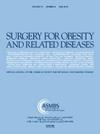减肥手术后 2 型糖尿病患者的致动脉粥样硬化指数趋势:一项全国队列研究。
IF 3.8
3区 医学
Q1 SURGERY
引用次数: 0
摘要
背景:减肥手术对体重减轻、代谢调节和肠道激素调节有深远影响,是控制肥胖和改善糖尿病预后的有效工具:减肥手术对体重减轻、代谢调节和肠道激素调节有深远影响,是控制肥胖和改善糖尿病预后的有效工具:本研究旨在评估接受减肥手术的 2 型糖尿病患者的动脉粥样硬化指数,包括血浆动脉粥样硬化指数(AIP)、动脉粥样硬化系数(AC)、卡斯泰利风险指数 II(CRI-II)和脂蛋白结合指数(LCI):2009年8月至2021年2月期间,伊朗德黑兰Hazrat-e Rasool医院(大学医院)外科为肥胖症和T2D患者实施了三种类型的手术,包括单吻合器胃旁路术/迷你胃旁路术(OAGB/MGB)、袖状胃切除术(SG)和Roux-en-Y胃旁路术(RYGB):在这项回顾性队列研究中,1246 名肥胖症和 T2D 患者接受了 3 种类型的减肥手术,包括 RYGB、SG 和 OAGB/MGB,并在术后 2 年接受了研究;数据来自伊朗国家肥胖症手术数据库。之后,在 5 次随访中评估了从基线到 2 年的生化指标、总减重(TWL%)和动脉粥样硬化相关指数的变化趋势:本研究共纳入了1246名接受减肥手术的T2D合并肥胖症患者。所有与动脉粥样硬化相关的指数,包括AIP、LCI、CRI-II和AC,在减肥手术2年后均呈显著下降趋势(分别为49.2%、53.4%、20.8%和22%)(P < .05)。在 6 个月随访、1 年随访和 2 年随访中,分别有 1023 人(83.10%)、719 人(57.70%)和 341 人(27.36%)参加。此外,术后2年,男女患者的高密度脂蛋白胆固醇水平均有明显升高(P < .05):减肥手术明显降低了动脉粥样硬化指数(包括 AIP、CRI-II、LCI 和 AC)的水平。本文章由计算机程序翻译,如有差异,请以英文原文为准。
The trend of atherogenic indices in patients with type 2 diabetes after bariatric surgery: a national cohort study
Background
Bariatric surgery has profound effects on weight loss, metabolic regulation, and gut hormone modulation, which make it an efficient tool for managing obesity and improving diabetes outcomes.
Objectives
The objective of this study is to evaluate the atherogenic indices, including atherogenic index of plasma (AIP), atherogenic coefficient (AC), Castelli’s risk index II (CRI-II), and lipoprotein combine index (LCI) in individuals with type 2 diabetes (T2D) living with excess weight, who have undergone bariatric surgery.
Setting
Three types of surgery including one-anastomosis gastric bypass/mini gastric bypass (OAGB/MGB), sleeve gastrectomy (SG), and Roux-en-Y gastric bypass (RYGB) were performed on patients with obesity and T2D in the period of August 2009 to February 2021 at the Surgical Department of Hazrat-e Rasool Hospital (University Hospital), Tehran, Iran.
Methods
In this retrospective cohort, 1246 individuals with obesity and T2D who underwent 3 types of bariatric surgery including RYGB, SG, and OAGB/MGB were studied for 2 years after the surgery; the data were derived from the National Iranian Obesity Surgery Database. Afterward, the trend of biochemical parameters, total weight loss (TWL%), and atherogenesis-related indices were evaluated from baseline up to 2 years in 5 follow-up visits.
Results
A total of 1246 patients with T2D and obesity who underwent bariatric surgery were included in this study. The trend of all atherogenesis-related indices, including AIP, LCI, CRI-II, and AC, showed a significant reduction (49.2%, 53.4%, 20.8%, 22%, respectively) 2 years after the bariatric surgery (P < .05). In the 6-month follow-up, 1-year follow-up, and 2-year follow-up, 1023 (83.10%), 719 (57.70%), and 341 (27.36%) individuals participated, respectively. In addition, a significant increase in high-density lipoprotein cholesterol levels was observed 2 years after the surgery in both sexes (P < .05).
Conclusions
The bariatric surgery significantly reduced the levels of atherogenic indices including AIP, CRI-II, LCI, and AC.
求助全文
通过发布文献求助,成功后即可免费获取论文全文。
去求助
来源期刊
CiteScore
6.70
自引率
12.90%
发文量
570
审稿时长
56 days
期刊介绍:
Surgery for Obesity and Related Diseases (SOARD), The Official Journal of the American Society for Metabolic and Bariatric Surgery (ASMBS) and the Brazilian Society for Bariatric Surgery, is an international journal devoted to the publication of peer-reviewed manuscripts of the highest quality with objective data regarding techniques for the treatment of severe obesity. Articles document the effects of surgically induced weight loss on obesity physiological, psychiatric and social co-morbidities.

 求助内容:
求助内容: 应助结果提醒方式:
应助结果提醒方式:


